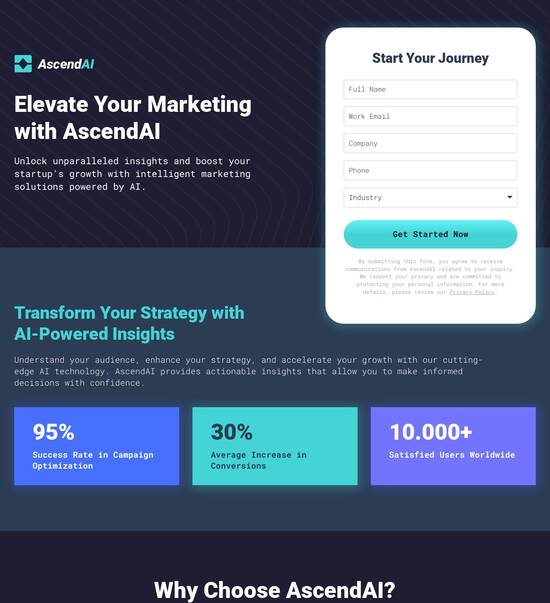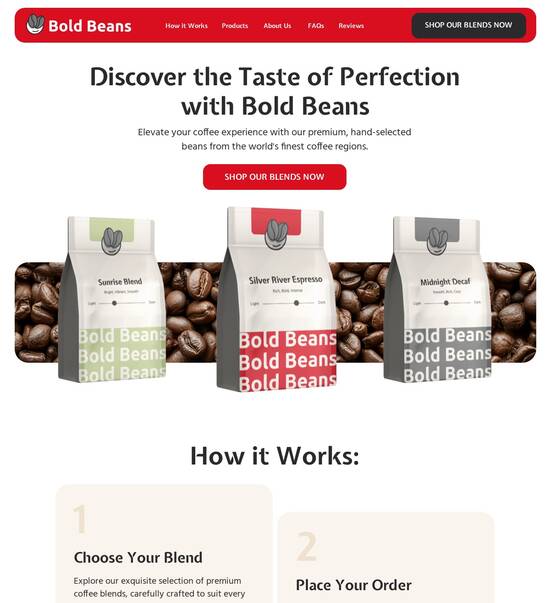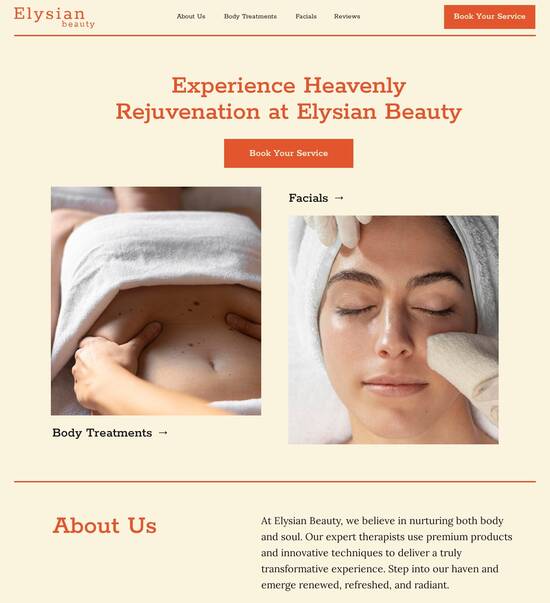
Landing page template for HR onboarding specialists
Use TemplateAbout template
Attract clients and showcase your skills with style using our landing page templates for HR onboarding specialists. Let's convert those visitors into clients!
Recommended templates

Easy to build without coding
With the intuitive drag-and-drop builder, anyone on your team can create high-converting pages without any knowledge of code or design. Make enhancements to your landing page with custom widgets using Javascript, HTML/CSS, or third-party scripts.

Multiple layouts for any industry and goal
Select from 500+ landing page layouts built to boost conversions across industry-specific scenarios. Customize them by adjusting fonts, adding images, and generating on-brand content with the AI assistant. Quickly scale with Instablocks® and Global Blocks that you can save, reuse, and update globally.

Loads fast and looks polished on any device
Every template is responsive, which means they present professionally on any device and load blazingly fast with our Thor Render Engine. You can also power them up with Google AMP technology to deliver an unparalleled mobile experience and drive higher conversions.

Robust analytics & experimentation
Get real-time updates and reporting across all your devices, showing the number of visitors, conversions, cost-per-visitor, and cost-per-lead. Launch AI-powered experiments, run A/B tests, and use heatmaps to analyze user behavior, then optimize your landing page to maximize conversions.







Easy to build without coding
With the intuitive drag-and-drop builder, anyone on your team can create high-converting pages without any knowledge of code or design. Make enhancements to your landing page with custom widgets using Javascript, HTML/CSS, or third-party scripts.
Multiple layouts for any industry and goal
Select from 500+ landing page layouts built to boost conversions across industry-specific scenarios. Customize them by adjusting fonts, adding images, and generating on-brand content with the AI assistant. Quickly scale with Instablocks® and Global Blocks that you can save, reuse, and update globally.
Loads fast and looks polished on any device
Every template is responsive, which means they present professionally on any device and load blazingly fast with our Thor Render Engine.
Robust analytics & experimentation
Get real-time updates and reporting across all your devices, showing the number of visitors, conversions, cost-per-visitor, and cost-per-lead. Launch AI-powered experiments, run A/B tests, and use heatmaps to analyze user behavior, then optimize your landing page to maximize conversions.
All the features you need to build lead-generating landing pages
Explore more featuresLearn how to build top-performing landing pages for any goal
FAQs
Leading the way in building high-performing landing pages





An essential guide to crafting a landing page template for HR onboarding specialists
Creating an effective landing page for HR onboarding is crucial in fostering a positive first impression for new hires. By utilizing Instapage's powerful features and extensive template library, HR specialists can design high-converting pages tailored to their onboarding needs in mere minutes. Let’s explore how to leverage these tools for optimal results.
Understanding the purpose of your landing page
Before diving into design, it's vital to clarify the objectives of your landing page. An HR onboarding landing page should not only present information effectively but also stimulate engagement and excitement about the new role. Consider focusing on the following elements:
- Branding: Align the design with your company's aesthetics to enhance recognition.
- Essential Information: Provide clear details on roles, schedules, and initial training sessions.
- Interactive Features: Incorporate elements that encourage interactivity, such as videos or quizzes, to maintain engagement.
Step 1: Selecting a template that suits your needs
Begin by choosing a landing page template that resonates with your company's HR goals. Instapage offers over 100 customizable templates specially designed to optimize conversions. Consider the following options when selecting your template:
- Conversion-focused layouts: Pick templates with proven performance metrics to boost engagement.
- Personalization options: Choose templates that allow dynamic content, ensuring the right message reaches the right audience.
- Mobile optimization: Ensure the template is responsive, catering to users across all devices.
Step 2: Customize your landing page with relevant content
Once you've selected a template, the next step is to customize it with content that resonates with new hires. Use the following tips to optimize your message:
- Clear headlines: Use concise and compelling headlines to attract attention instantly.
- Visual elements: Add engaging images or videos that reflect your company culture.
- Call-to-Action: Create inviting CTAs that guide new hires through the onboarding process.
Step 3: Optimize for conversions
After building your landing page, leverage Instapage's optimization tools to ensure it achieves high conversion rates. Utilize the following techniques:
- A/B Testing: Experiment with different headlines, images, and layouts to determine what resonates best with your audience.
- Analytics: Use detailed heatmaps and analytics dashboards to track user behavior and make data-driven adjustments.
- Feedback collection: Consider gathered feedback to further refine the onboarding experience.
Ultimately, an effective landing page for HR onboarding not only informs but also engages new hires, easing them into their new environment.
Ready to create your ideal HR onboarding landing page? Start with Instapage today and transform your onboarding process!
People also ask about Landing page template for HR onboarding specialists
Landing page template for HR onboarding specialists
Understanding the nuances of HR onboarding: Setting the stage for success
Effective employee onboarding is a crucial component of the hiring process. It sets the tone for how new hires perceive their role and the organization at large. Onboarding encompasses everything from paperwork and compliance training to culture acclimatization and relationship building. HR leaders play a pivotal role in ensuring that this phase isn’t just a formality but a strategic engagement that prepares new employees for success.
HR professionals must foster a welcoming environment that integrates new hires quickly and meaningfully. A positive onboarding experience can significantly impact retention rates and overall employee satisfaction. In fact, studies show that organizations with effective onboarding processes can improve their retention rates by as much as 82%. By actively engaging newcomers, organizations can pave the way for a loyal, productive workforce.
The landscape of onboarding templates: What do they offer?
Onboarding templates streamline the entire onboarding process, offering HR specialists a standardized yet customizable approach to welcome new team members. Key characteristics of effective onboarding templates include elements such as a welcome message, a checklist of required documents, introduction to company policies, and an overview of job-specific training. These templates not only save time but also ensure that essential information is delivered consistently.
A structured welcome message that sets a positive tone.
Comprehensive checklists to keep track of progress and tasks.
Placement for multimedia content like videos and infographics.
Opportunities for feedback loops to improve the process continually.
Tailoring these templates to match branding and company culture strengthens the onboarding experience. By ensuring that new hires receive a consistent message that echoes the company’s values, organizations can create a cohesive brand experience that resonates with incoming employees.
Creating a cohesive brand experience
One of the most impactful ways to enhance the onboarding experience is through branding. When onboarding materials, including landing pages, align with the company’s branding and culture, it fosters a sense of belonging. Strategies for seamlessly incorporating company values include using branded visuals, consistent messaging, and highlighted introductions to core team members. Each element reaffirms the company ethos and shows new hires how they fit into the larger organizational narrative.
Incorporate branded visuals that echo the company’s identity.
Communicate the mission and values through storytelling.
Include introductions that emphasize team collaboration and support.
Companies such as Google and Netflix leverage branded onboarding processes effectively. Google’s onboarding program, for instance, immerses new hires in the company culture from day one and outlines clear expectations. This approach enhances new employee engagement, facilitates quicker team integration, and establishes a shared understanding of company values.
Features that make a difference: The essential tools of effective onboarding pages
User experience design is a cornerstone of effective onboarding pages. A seamless navigation layout is critical for not overwhelming new hires with information. Responsive design allows access to onboarding content across various devices, ensuring that newcomers can engage with materials at their convenience. Intuitive forms, well-structured checklists, and visually appealing elements make the onboarding process smoother and enhance information retention.
User-friendly navigation that guides applicants through the onboarding process.
Responsive designs that adapt to different devices for accessibility.
Clear forms and checklists that help track progress effortlessly.
An organized and engaging onboarding experience can significantly shape how new hires perceive their roles and the company. By streamlining processes through user-centered design, HR managers can maximize the onboarding experience, leading to higher satisfaction and retention.
Interaction and engagement: Keeping new hires involved
To foster engagement during onboarding, multimedia elements such as videos and infographics serve as effective tools. These components not only capture attention but also enhance information retention by presenting complex information in a digestible format. Additionally, incorporating interactive elements like quizzes and surveys allows new hires to engage actively with onboarding material, reinforcing their understanding and engagement.
Educational videos that clarify company objectives and processes.
Interactive quizzes that test knowledge and boost retention.
Surveys to collect feedback on the onboarding process.
Gamification techniques also add a layer of fun to onboarding, making it memorable. By turning certain tasks into games or challenges, organizations can create an engaging and appealing onboarding atmosphere. This ultimately results in a welcoming experience that encourages productivity and connectivity within the workplace.
Implementing an employee onboarding checklist template: A practical approach
A comprehensive onboarding checklist serves as the backbone of any effective onboarding process. Essential components include documentation requirements, training modules, and introductions to key team members. Timelines are crucial; organizations should clearly define expectations at each stage of the onboarding journey, from the first day through to the completion of introductory training.
Documentation completion, including tax and identity verification forms.
Training modules specific to the new hire’s functional area.
Introductions to team members and stakeholders across departments.
Customizing checklists based on various roles ensures that new employees receive the information pertinent to their responsibilities. By offering a structured yet flexible onboarding checklist, HR professionals can create a personalized experience that promotes confidence and clarity.
Tracking progress and making adjustments
HR leaders play a crucial role in tracking the effectiveness of onboarding through various metrics and tools. Feedback loops, in the form of surveys and one-on-one sessions, can yield valuable insights that inform adjustments to onboarding checklists and templates. Organizations that see onboarding as an iterative process tend to experience improvements in engagement levels and retention rates.
Track new hire feedback to identify areas for improvement.
Utilize onboarding metrics, such as time-to-productivity and employee satisfaction rates.
Establish regular reviews of onboarding processes to refine approaches continually.
Case studies emphasize organizations like Zappos, which employ iterative onboarding practices to enhance employee experiences. By focusing on continuous improvement within their onboarding protocols, Zappos has created a memorable introduction for new hires, which contributes significantly to their high retention rates.
Empowering HR professionals with data-driven insights
Analytics play a critical role in optimizing the onboarding experience. By collecting data on various metrics, HR professionals can identify trends and pinpoint areas that need improvement. Leveraging these insights can lead to better-targeted onboarding strategies that address specific employee needs, ultimately facilitating a smoother adjustment process.
Collect data on employee satisfaction regarding training modules.
Analyze trends in time-to-productivity across departments.
Adjust onboarding materials based on feedback and performance metrics.
Key performance indicators (KPIs) such as retention rates and performance metrics allow HR leaders to measure the success of their onboarding programs. By regularly reviewing these indicators, organizations can adapt their onboarding processes to better fit the evolving workforce landscape.
Building a culture of continuous improvement
Creating a culture of continuous improvement requires HR leaders to foster open communication channels with new employees. Regularly soliciting feedback can reinforce the message that their opinions matter and that the organization values their input. Supporting an environment conducive to sharing experiences will help ensure that onboarding processes evolve effectively.
Establish an open-door policy for new hires to voice concerns.
Incorporate regular feedback sessions through surveys and focus groups.
Adapt onboarding materials based on the evolving needs of new hires.
Long-term benefits of adapting onboarding practices based on employee input include increased morale, enhanced team collaboration, and improved retention rates. By committing to continuous improvement, HR efforts in cultivating a nurturing corporate culture will yield substantial returns.
Bridging technology and human touch: The future of onboarding
The future of onboarding is being shaped by innovative technologies that bridge the gap between human touch and automation. Artificial intelligence and automation play a significant role in optimizing onboarding templates, making processes more efficient while personalizing the experience based on employee data.
AI tools for personalized onboarding recommendations.
Virtual reality (VR) for immersive training scenarios.
Augmented reality (AR) for real-time support during onboarding.
The role of these technological advancements is invaluable for creating engaging training experiences that resonate with new hires. Predictions show that as these technologies become more refined, they will dramatically change how onboarding is executed, shifting from a primarily manual process to an integrated, data-driven experience.
Aligning team objectives with employee development
Successful onboarding is not merely an HR function but requires alignment with wider organizational goals. HR teams need to collaborate with other departments to define shared objectives during the onboarding process. This synergy ensures that new hires are aware of how their roles contribute to broader company initiatives.
Coordinate with department heads to synchronize onboarding content.
Set collective targets for new hire performance across teams.
Ensure onboarding materials reflect the company vision prominently.
Highlighting the value of alignment during onboarding not only clarifies new employees’ roles but also boosts morale within teams. Organizations that focus on integrated onboarding often experience a quick ramp-up in productivity, showcasing the holistic benefits of collaboration.
Conclusion: The transformative power of effective onboarding
Creating optimized landing pages for onboarding specialists is about more than just functionality; it's about crafting an experience that speaks to new hires. The journey of developing effective onboarding protocols rests on the foundation of strategic insight, continuous feedback, and innovative practices.
By embracing technology and aligning team objectives, organizations can ensure that their onboarding processes not only welcome new employees but immerse them in a culture of growth and collaboration. The transformation resulting from effective onboarding is multifaceted, promising enhanced employee satisfaction and retention in the long run.
Ready to skyrocket conversions?
Supercharge your ad campaigns with high-performing landing pages
Get started














